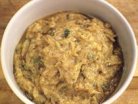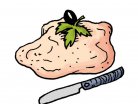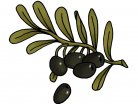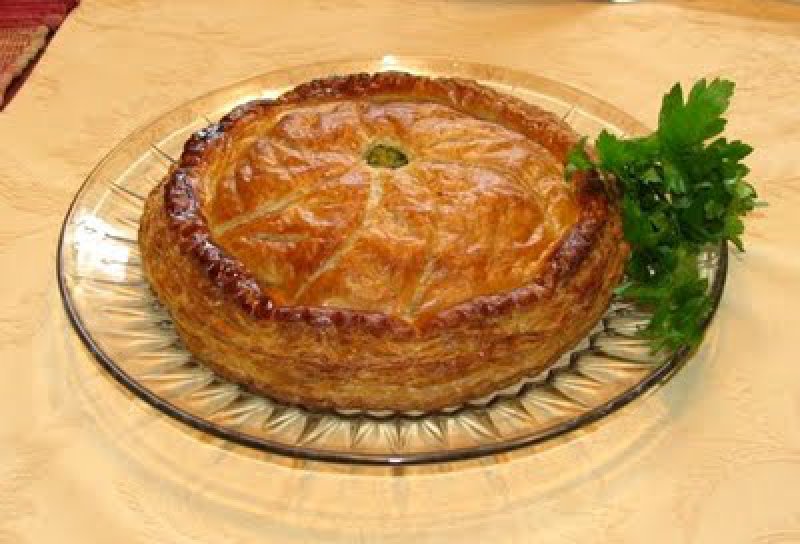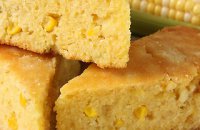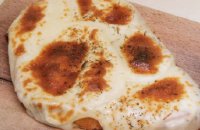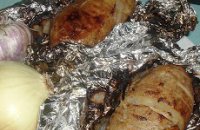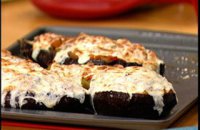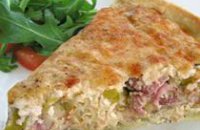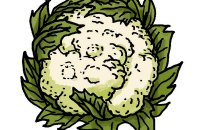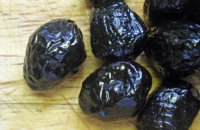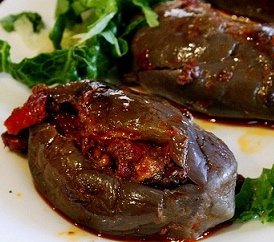Ham pithiviers
Ham Pithiviers - Ham & Hard Cooked Egg Leftovers Put to Good Use
Ingredients:
2/3 previous puff pastry (cut after rolling out, as described in this recipe)
6 ounces (180 g) best-quality boiled ham
2 Tbs butter
2 Tbs minced shallots or scallions
2 egg yolks
1/4 cup (1/2 dL) heavy cream
s of Worcestershire sauce
s of hot pepper sauce
freshly ground pepper
6 Tbs freshly grated Parmesan, Swiss, and/or Cheddar cheese
egg glaze (1 egg beaten with 1 tsp water)
Equipment
a baking sheet, round nonstick pizza tray recommended
a roller-pricker, or two table forks
a pastry brush"
Procedure:
For the ham filling: Cut the ham into thin, irregular slices about 1 by 1 by 1/8 inches (2 ½ x 2 ½ x ½ cm) and sauté briefly in the butter with the shallots or scallions, just enough to warm through thoroughly. Remove from heat. In a small bowl, beat the egg yolks with the cream. Stir this mixture onto the ham along with the Worcestershire and pepper sauce and add freshly ground pepper to taste. Warm over a low heat, folding the ham into the sauce until it thickens but does not boil. Set aside to cool and thicken even more. It should be cold when it goes into the Pithiviers.
Forming the dough: Roll out the dough (the whole of the recipe) into a rectangle about 18 by 9 inches (45 x 20 cm) and cut into thirds crosswise; refrigerate the 2 pieces, wrapping and storing one of them for another use. Roll remaining piece, which will serve as the bottom of the tart into a square 12 inches (30 cm). Using a pie plate or cake pan to guide you, cut a 9 ½ -inch (24 cm) disk out of the center of the dough. Remove surrounding dough and set on a bake sheet for reconstituting later. Lightly fold disk in half and set upside down on a dampened baking surface. Roll out the second piece of dough to a thickness of slightly more than ¼ inch (3/4 cm) (it must be of this thickness in order to puff) and cut it into a disk the same size as the first. Refrigerate it along with the surrounding dough pieces from both disks.
* The dough disks may be formed and stored in the freezer.
Assembling the pithiviers: With your fingers, push and pat the bottom disk of dough onto its baking surface to make an even circle, slightly larger than your cutting guide. With a roller-pricker or two forks, prick dough all over at ½-inch (1 ½ cm) intervals, going down through the pastry sheet to keep this bottom layer from rising too much. Form the ham into a round cake, about 4 ½ to 5 inches (12 to 13 cm) across -layers of ham interspersed with sprinklings of cheese- and place in the center of the dough. It is important to leave a 2-inch (5 cm) border of clear dough all around the ham to prevent leakage during baking. Brush border of dough with cold water and immediately center the top layer in place, stretching it gently if necessary. With a sharp-pointed knife, make a little hole 1/8 inch (1/2 cm) wide in the center of the dough, reaching down into the filling to allow steam to escape during baking. Then, with the ball of your first three fingers, firmly press the two pieces of dough in place all around. (Dough should probably be chilled at this point, but if it is still firm, proceed to the scalloped edging described in the next step and then chill it.)
* The pithiviers may be airtight wrapped and frozen at this point or after the scalloped edging. It may then be decorated and baked, still in its frozen state.
Decorating the Pithiviers: Preheat the oven to 450° F / 23O° C and set the rack in the lower-middle level. Make a scalloped edging around the Pithiviers as follows: set an upturned bowl slightly smaller than the Pithiviers over it and use it as a guide to cut 2-inch-wide (5 cm) scallops all around the circumference; decorate their edges by pressing upright lines against them with the back of a knife. Just before putting it in the oven and after making sure that the top of the dough is chilled and firm, brush the top with a film of egg glaze, wait for a minute and brush a second film of glaze. Finally, with the point of a small knife, cut decorative lines 1/16 inch (1/4 cm) deep in the top of the dough. A typical pattern is curving lines from center to edge like the spokes of a wheel or trace 4 long ovals from center to edge with straight lines and shallow crosshatch marks in between.
Baking, holding and serving: Baking time: 45 to 60 minutes. Place the Pithiviers in a preheated oven and bake for about 20 minutes, until it has puffed and is beginning to nicely brown -it should rise to a height of at least 2 inches (5 cm). Lower the oven to 400° F / 200° C and bake for another 20 to 30 minutes, watching it to ensure that it does not brown too much (cover loosely with foil if it does and turn the thermostat a little lower if you think it is necessary). Baking takes longer than you might think, since all the pastry layers should cook and crisp. The Pithiviers should be done when the sides feel quite firm; turn oven off and leave the Pithiviers in for another 10 to 15 minutes to make sure. You may keep it in a warm oven or on an electric hot tray for an hour or more, but the sooner you serve it the more tenderly, flaky and delicious it will be. To serve, simply cut with a serrated knife into wedges just like a pie.





































